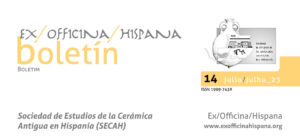
Last July, the Boletín Ex Officina Hispana number 14 of the Sociedad de Estudios de la Cerámica Antigua en Hispania (SECAH) was published. A new issue with an interesting editorial dedicated to “La aportación de los pecios a los estudios cerámicos en época Antigua” by Rut Geli (pp. 2-5) and the main article “La cerámica de la Edad del Hierro y el cambio de Era en Galicia: estado de la investigación y perspectivas de futuro” by Alba A. Rodríguez Nóvoa (pp. 112-129). Among the 27 news about pottery productions from ancient and medieval times in the Iberian Peninsula, we stand out for its theme “Apuntes sobre algunas ánforas griegas documentadas en el litoral gaditano y sus implicaciones arqueohistóricas” by Carmen Ramírez Cañas and Antonio M. Sáez Romero (pp. 10-14), on the presence of Magno-Greek amphorae from the second half of the 5th century BC in the Cádiz area; “A propósito de un fragmento inédito de un lagynos de engobe blanco procedente de Mesas de Asta (Jerez de la Frontera) by Álvaro Miranda García and Antonio M. Sáez Romero (pp. 18-23), on a Hellenistic lagynos of oriental production; “Una forma particular de cerámica ibérica de engobe blanco de influencia griega procedente de Pollentia (Alcúdia, Mallorca) by Joel Bellviure et alii (pp. 23-26), on a jug of Emporitan production from the end of the 2nd century BC of clear Greek tradition; and “Un ánfora tripolitana antigua con marca ARIS hallada en Sant Joan Despí” by Alejandro Ros Mateos and Jordi Roig Buxó (pp. 27-31), on a stamp in the Greek alphabet on an ancient Tripolitan amphora from the second half of the 2nd century BC.
More information:
SECAH website: https://www.exofficinahispana.org
Link to the Boletín number 14: boletín ex officina hispana nº 14 - secah
More news
A set of Attic pottery from the Iberian necropolis of Alarcos III (Poblete, Ciudad Real) published
The article "Un depósito de ofrendas de cerámica ática y ungüentarios en la necrópolis ibérica de Alarcos III (Poblete, Ciudad Real)" has been published in the current issue of Archivo Español de Arqueología (AEspA 98 -2025-, 724. DOI: https://doi.org/10.3989/aespa.098.025.724) by Pedro Miguel-Naranjo, Miguel Ángel Rodríguez-Rabadán, Francisco Javier Morales Hervás, David Rodríguez González and M.ª...

Information about Dr. Xavier Aquilué (Iberia Graeca)
On September 6, Dr. Xavier Aquilué Abadías, scientific director of Iberia Graeca Centre at the Museu d’Arqueologia de Catalunya, retired after a long professional career in various public (Ajuntament de Badalona, Ajuntament de Tarragona, Diputació de Barcelona and Generalitat de Catalunya) and private (Col·legi Oficial d’Arquitectes de Catalunya) administrations. Dr. Aquilué expressed his gratitude...

Colección Museográfica de Cártama. Catálogo de la Colección Expositiva
Last December, the Consejería de Turismo, Cultura y Deporte de la Junta de Andalucía and the Ayuntamiento de Cártama (Málaga) published the book Colección Museográfica de Cártama. Catálogo de la Colección Expositiva, which includes an inventory of the 197 archaeological objects that make up the permanent exhibition of this collection managed by the Ayuntamiento...

Proconessian Marble Altar or Ablution basin discovered in El Turuñuelo
During the seventh archaeological excavation campaign carried out last June at the Tartessian site of Casas del Turuñuelo (Guareña, Badajoz, España), 27 fragments of a base and a fluted shaft of an architectural element of marble from the Greek island of Proconnese (Asia Minor) were found. The discovery dates from the destruction phase of...

Greeks in the Phoenician-Punic city of Baria (Villaricos, Almería)
On April 23, Nature journal published the article “Punic people were genetically diverse with almost no Levantine ancestors” which compiles the findings of a genetic (DNA) study of 210 individuals from 14 Phoenician-Punic necropolises in the central and Eastern Mediterranean (North Africa, Iberia, Sicily, Sardinia, and Ibiza). This ambitious project involved 64 international researchers,...

Reading Ancient Objects Inside Out. Greek Figure-Decorated Pottery in Portugal
In December 2024, the book Reading Ancient Objects Inside Out. Greek Figure-Decorated Pottery in Portugal was published in the Archaeopress Archaeology series. The scientific editors are Rui Morais, Delfim Leão, Maria de Fátima Silva, Daniela Ferreira, and David Wallace-Hare. The monograph examines Greek vases preserved in various museums and collections in Portugal through two...

Call for the Third Autumn International Research Bursary (l’Escala, 2025)
For the third consecutive year, the City Council of l’Escala (Alt Empordà, Girona) has announced the “Third Autumn International Research Bursary” for research in the social and natural sciences. The scholarship is awarded to the best project submitted whose theme subject of study is related to the landscape, natural environment, history, archaeology, anthropology, and...

The Greeks in Iberia and their Mediterranean context
Routledge has published the book The Greeks in Iberia and their Mediterranean context (New York, 2024), edited by Jens A. Krasilnikoff and Benedict Lowe, which collects the papers presented at the workshop held at Aarhus University (Denmark) on October 10 and 11, 2013, more than ten years ago, by different researchers of various nationalities....

Phicaria XI. Encuentros Internacionales del Mediterráneo (Mazarrón, March 7-9, 2025)
Once again, the Universidad Popular de Mazarrón, with the la collaboration of the Universidad de Murcia and the Agencia de Ciencia y Tecnología de la Región de Murcia, organizes, on March 7, 8 and 9, the 11th edition of Phicaria. Encuentros Internacionales del Mediterráneo that will take place at the headquarters of this University....

Scientific conference at the MAN: Entre Caos y Cosmos. Naturaleza en la Antigua Grecia
Next Thursday, February 20, the Museo Arqueológico Nacional (MAN) will hold a scientific conference around the temporary exhibition Entre Caos y Cosmos. Naturaleza en la Antigua Grecia (October 30, 2024 to March 30, 2025). The conference will take place in the museum’s auditorium, between 10:00 a.m. and 7:15 p.m., and its objective is to...
